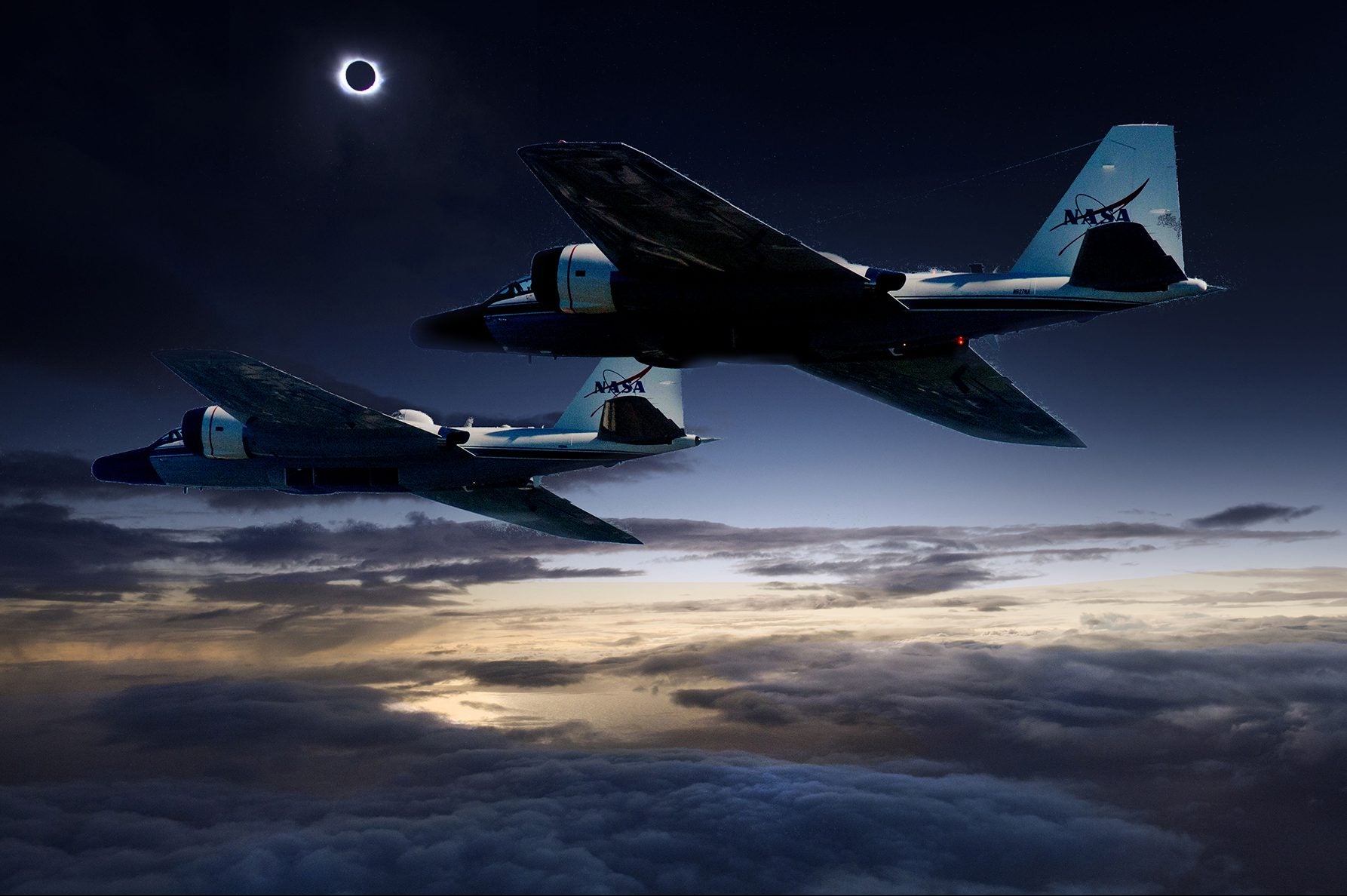High-altitude jets rigged with telescopes will chase the solar eclipse across the US
Two minutes and forty seconds. That’s the longest anyone positioning themselves along the path of “totality,” where the moon will slide completely in front of the sun during the North American solar eclipse on August 21, can hope to bask in the full expression of the moon’s shadow. At least, if you’re Earthbound.


Two minutes and forty seconds. That’s the longest anyone positioning themselves along the path of “totality,” where the moon will slide completely in front of the sun during the North American solar eclipse on August 21, can hope to bask in the full expression of the moon’s shadow. At least, if you’re Earthbound.
For a group of scientists who have retrofitted telescopes to the noses of two NASA research jets, totality will last seven and a half minutes—once their data is all stitched together.
Scientists typically commission NASA’s high-altitude WB-57F jets to do things like image tropical cyclones or study clouds. “This is the first mission for airborne astronomy,” says Amir Caspi, a solar astrophysicist with the Southwest Research Institute who specializes in high-energy processes on the sun. He’s the lead investigator on the project, one of 11 that NASA chose to fund for the day of the eclipse.
The two jets will fly one behind the other 70 miles apart, chasing the moon’s shadow on Earth as it passes along the diagonal eclipse track from Oregon to South Carolina. At 50,000 feet, they will be high enough to give scientists quality, cloud-free footage without the expense of actually going to space—and just low enough so that the pilots don’t have to wear pressure suits.
The nose of each jet will sport two telescopes that swivel on turrets; one will observe visible light, and the other will observe infrared light. As the jets fly, the telescopes will alternate between two targets: The sun’s corona, and Mercury, the planet closest to the sun, which is almost impossible to watch at any time other than a solar eclipse.
The science that comes out of this mission could change our understanding of how the sun works, and—if all goes well—produce the first heat map of Mercury (using the infrared telescope). That could tell us more about what the elusive planet is made of—that’s right, we don’t yet completely know.
Untangling the mystery of how the sun runs so smoothly
The sun has a corona made of plasma that flows outwards from the sun and then doubles back towards it, in elaborate loops and arcs created by lines of magnetic force. Each of these arcs of plasma have two “footpoints,” like the ends of a rainbow. The footpoints are rooted on the sun’s surface, which is in constant, roiling motion—“like a pot of boiling water,” Caspi says. “So that should be moving the footpoints around and causing a tangled, giant mess. And that’s what our modeling shows should happen as well.”
But, somehow, that doesn’t happen. “They stay reasonably well combed, so to speak,” Caspi says. “They don’t look like bed head. They look like a fresh hairdo.” And no one understands why.
Occasionally, the loops and arcs do get a little tangled up. But as soon as they do, the corona self-corrects, spitting out the tangle as a solar flare or “coronal mass ejection” before returning to its usual organized chaos.
This isn’t just theoretical science; it has a real impact on life on Earth. “Solar flares can cause radio interruptions on Earth, but even bigger dangers come from coronal mass ejections.” Caspi says. “That’s when the sun throws off billions of tons of material, and the particles can come toward Earth. When that happens, it can knock out satellites, it’s a hazard for astronauts, and it can knock out power systems here on the ground.”
If physicists can better understand how the corona stays mostly organized, they might begin to predict coronal mass ejections.

The baby solar-flare conundrum
“Nanoflares” are another great mystery of the sun: Physicists theorize that there are many miniature solar flares erupting constantly like firecrackers on the sun’s surface. (Caspi notes that “miniature” here is all about context: “The amount of energy being expended would be about 1,000 atom bombs per nanoflare,” he says.)
For now, they’re just one of a number of theories scientists have put forth to explain how the corona gets heated to several millions of degrees, while the sun’s surface a relatively cool 10,000°F (5,600°C).
“People have made observations of 10 million degree plasma in the corona, and that kind of heat is suggestive of nanoflare heating,” Caspi says. “Nanoflares are a theory, and we think they exist, but we don’t really know for sure.”
Could the sun be spitting out miniature flares so numerous that they transfer enough energy to superheat the corona? And could they be happening so frequently at such a small scale that they haven’t been detected as individual events by our telescopes so far?
These are other questions Caspi hopes to help answer using this jet-plane approach.
A chance to see Mercury, the washed-out planet
Mercury is the closest planet to the sun, which means studying it is a real pain. It’s washed out by the sun’s brilliance nearly all the time, and when the sun sets, so does Mercury. The exceptions are two very specific occasions: 1) Every nine months, there are a few days where, at dusk, Mercury briefly stays low in the sky after the sun drops below the horizon, and 2) during a total solar eclipse. And for a planetary physicist, eclipse Mercury is so much better; you don’t have to peer through layers of Earth’s hazy sunset atmosphere to see it.
Constantine Tsang, a planetary physicist with the Southwest Research Institute, is leading the Mercury-viewing portion of the jet flights. Both pairs of telescopes will swivel to Mercury for 30 minutes before totality, and for 30 minutes after. But the star of the show will be the infrared telescopes; Observing Mercury in infrared will give Tsang and his team a temperature map of the planet. “We’ve never been able to do this before,” says Tsang.
They’re trying to understand how long it takes Mercury’s surface soil to cool off after it turns away from the sun and enters its “night” phase. If they can figure that out, they’ll start to understand how compact the surface material is. Is it rocky and dense, or more loose, like sand? Think of hot-stone spa treatments: Dense rock retains heat for longer. (There’s a reason it’s not a hot-sand spa treatment.)
“If you know how compact things are, we can start thinking about the history of the soil,” Tsang explains. From there, researchers can begin to better understand how Mercury formed, something that is only partially understood now.
“Mercury will be high in the sky and we’ll have complete darkness,” Tsang says, perfect for watching the planet. “In total, we’re going to have about two hours of Mercury data.”
But like all novel approaches to science, there’s no guarantees. “No one’s really attempted this to the best of our knowledge,” says Tsang. “So we don’t really know if it will work.”
This story has been corrected to indicate the correct formation of the jets, more accurately describe the dangers posed by coronal mass ejections, and to note that Mercury is visible above the horizon a few days every 9 months, not just one.